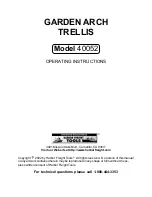
Operating Instructions & Parts Manual
Page 6
Seating
Your
Diamond:
Caution:
To ensure accuracy, mount the indentor by sliding it in the holder as far as possible and then securing the
indentor by tightening the set screw finger‐tight only.
Place HRC test block on the small round anvil and begin by turning the handwheel clockwise until the block just
touches the diamond. At this point, continue rotating the handwheel until the large needle goes around approx. 3
revolutions. Let the machine sit idle for a few seconds and then loosen the set screw. Wait a few more seconds and
then tighten the set screw back up. This will allow the diamond to be “seated” in the shank. Take the load off by
turning the handwheel counter‐clockwise and you can begin following instructions below.
Rotate the weight adjustment knob until the required weight scale is aligned with the alignment mark on the frame of
the machine.
1.
Prepare the test specimen properly. Be sure that the top and bottom surfaces of the specimen are clean and free
of any grease, oil dirt, etc and free of any burrs or debris.
2.
For small specimens (under 3" maximum length or diameter) use the small round anvil. Use the large anvil for
larger specimens. Use the V‐shaped anvil for round or curved specimens.
Warning!
Do
not
test
any
specimen
that
cannot
be
safely
and
properly
positioned
on
and
supported
by
the
tester
anvil
.
Operation:
Determine the proper indentor, scale and weight for the material hardness to be tested (see Figure 3). Mount the
required indentor in the indentor holder using the set screw (Fig. 6, Ref. Nos. 27 and 28) on the side of the holder.
Test
Procedure
Test procedure consists of a preload of the specimen using the force of the elevation screw and a test load using the
weights and lever arm assembly. Be sure that the weight reset handle is in rest (“unload”) position.
1.
Mount specimen on required anvil. Rotate the elevation screw threaded collar clockwise slowly until the
specimen contacts the indentor. Be sure to position specimen so the indentor contacts clean, untested material.
2.
Preload the specimen by rotating the leadscrew collar slowly until the large needle on the dial indicator rotates
two to three (2‐3) revolutions. Stop rotation of handwheel when the large needle is within 3 hash marks of
vertical(TDC)
Caution:
As
the
large
needle
is
properly
rotated
2
‐
3
revolutions,
the
small
needle
rotates
counterclockwise
90
to
vertical
at
the
red
dot.
If
the
large
needle
overshoots
vertical
by
more
than
5
hash
marks,
the
test
is
invalid
and
must
be
repeated
from
step
1.
3.
Rotate the bezel so that the hash mark at the “0” mark at the top of the dial is aligned with the large needle.
4.
Pull the weight release handle to apply the major load. Wait until the large needle stops rotating, approx. 5‐8
seconds. This 5‐8 second “dwell” time can be adjusted by turning valve on dashpot.
5.
Slowly push the weight reset handle back until it resets and locks in the reset position.
6.
Read the material hardness from the required scale on the dial.
7.
Rotate the handwheel counterclockwise to lower and release the specimen.







































